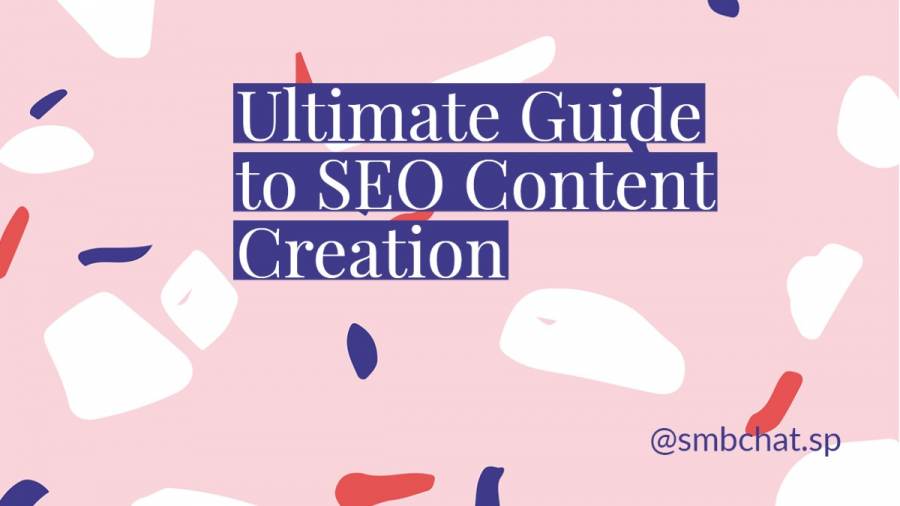The Subtle Art Of Not Creating Mediocre Content
There are two very important days in the life of a content marketer; the day he is born, and the day he learns how to create content.
Every marketer knows the day they were born, but you’ll be shocked at the number yet to master content creation.
Fortunately, today is more than your lucky day. Mark it in your calendar because today is the day you master the intricacies of content creation.
Drumroll …
The Numbers Behind The Hype
Content creation and marketing has been doing numbers this past year. It’s all everybody talks about, and even your local grocery store is probably developing a content strategy.
Well, is the hype real, or is this another fad that nobody will remember five years from now?
There’s only one way to find out. Let's look at the numbers:
- 60% of marketers say that blog content creation is their top inbound marketing priority
- 89% of companies think blogging will be important in the next five years
- The average company that blogs generates 55% more website visitors and 35% more inbound links.
- 60% of marketers create at least one piece of content each day
- Content marketing costs 62% less than traditional marketing but generates 3 times as many leads.
Enough with the numbers, let's get to the step-by-step guide of taking your content quality to the next level.
Documenting an Equally Effective Content Strategy
That beautiful blog you were adoring last night had a journey that started way before the blogging process. It’s not by accident or by chance that it’s compelling content, it's been a long time coming.
There was a well-documented plan and strategy and a lot of steps before the final refined product landed on your screen.
People sat down somewhere, took time, brainstormed, and came up with a plan that had you in mind. That’s why you can’t have enough of that HubSpot article.
This brings us to the first step of content creation: developing a content strategy.
1. Developing SMART goals
Not all companies create content for the same reasons. That said, it’s crucial to find out your intent i.e., Why you want to create content in the first place.
Some of the reasons for content creation today include:
- Lead generation
- Thought leadership
- Education
- Launching a new product
- Relevance and customer retention
Once your team has a clear picture of the “Why?”, you would be in a better position to develop a way forward and a plan to achieve your business goals.
From there, you should go ahead and create targets and goals. You do this by answering the question “What does success mean to me?”
Your goal in mind should be:
- S- specific
- M- Measurable
- A-Attainable
- R- realistic
- T-timebound
2. Building Buyer Personas
A lot has changed since the 80s, there’s no longer one group of people called the “customer” anymore.
There’s Anna a CEO who's gender neutral, there’s Amy a marketing director who’s vegan, and Paul who’s a boomer.
On that premise, a one-size-fits all approach won’t cut it- it may have once- but not anymore. This brings us to the second most important question in content creation “who is your target audience.”
An excellent way of finding who your audience is creating buyer personas that reflect the entire length of your client lifecycle.
Buyer personas are detailed descriptions of your target audience. They cover the target audience’s pain points, careers, beliefs, philosophies and goals.
You can create a buyer persona with the following steps:
- Compile data on your target audience (age, location, gender, corporate rank, etc.)
- Find Out the social channels popular to your audience ( e-mail, Instagram, Facebook, LinkedIn)
- Identify what keeps your customer up at midnight- their pain points
- Identify the goals and aspirations of your target audience
- Discover the type of content your target audience loves
- Look at client testimonials and feedback from current customers
- Leverage this data to build a buyer persona
3. Create Your Prospective Customer's Journey
Picture this, you created the best content this side of inbound marketing, built great buyer personas and hired the best writers . Above that, your prospects read it and actually like it, now what?
As you create content, it’s crucial to see the beginning from the end, and build a road map for your client's lifecycle through your content.
Remember, content creation is not a destination, but a journey itself. Subsequently, each step of your content creation should bring you closer to your goals.
The three stages that define a solid buyer's journey are based on the sales funnel. They include:
- Awareness
- Consideration
- Decision
Some of the questions that will help pull you through your buyer journey include:
- Where does my reader go after this?
This is a question many content creators never bother to ask themselves. If you want your reader to move on to another article, you can use backlinks to guide them.
If you want a reader to purchase a product or to convert, you can use calls to action throughout your blog.
- What happens if my reader can’t finish the content?
We’ve all been there; reading a blog halfway and then moving to something else. If this happens the best thing is to try and close the deal a few moments after your reader reads your blog. This is where landing pages come in.
4. Do Proactive Content Auditing
Once you’re done with the process, it’s necessary to scrutinize your strategy and its resultant content from time to time.
Remember that your strategy is not set in stone. To the contrary, it’s a living thing that you can change, refine, update and improve from time to time.
Furthermore, a content audit shouldn’t be a reactive measure- you shouldn’t be doing it whenever things go wrong or when you’re not meeting targets and expectations.
Content auditing should be a process that goes on throughout, regardless of the circumstances.
Some steps you can take to begin keeping track of your content include:
- Step 1:Create a Google spreadsheet
- Step 2:Create columns for keyword focus, search volume, search intent SERP ranking and buyer personas
- Step 3:Create columns for essential KPS such as search rankings, page engagement, pageviews, conversions likes and shares
- Step 4:Rank each post according to its performance
- Step 5: Remove or repurpose outdated content
Promoting Your Content
Creating outstanding website content is just the beginning. It won’t be long before any content manager realizes that target audiences just don’t flock to your website the same way they do when Marvel movies come out.
Many content strategists realize too late that content, like everything else(even Marvel movies) needs promotion. Without promotion, you don’t get readers and without readers, well never mind.
Some of the channels that will give you a leg up over your competitors in content promotion include:
1. Social Media
Social media is a juggernaut in marketing itself; it’s even a bigger one in marketing content. There isn’t a successful blog out there that doesn’t leverage social media to bring it's target market within its reach. You should too.
Some of the techniques you can follow to use social media to your advantage include:
- Use catchy and intriguing headers to hook your target market
- Use equally captivating graphics and images as you structure content
- Use hashtags to jump on to trends
- Leverage plugins such as Click to Tweet on your blog
- Join Facebook and LinkedIn groups among other communities
2. Email Marketing
E-Mail has remained the darling of marketers for years now, and it’s not going away anytime soon.
You probably didn’t know that every $1 spent on e-mail marketing generates $42. With numbers like this, who wouldn't want to be part of the e-mail train.
Furthermore, there's always space for your blog in your clients email inbox besides that Uber, KFC and The New York Times mail.
Some techniques you can use to perfect your email promotion game include:
- Design an RSS feed for your blog
- Using catchy headers and titles to hook readers
- Leveraging brief and compelling summaries
- Use non-text content such as images
- Consider adding opt-in pop-ups
- Including digits and percentages in your headers
- Use metrics like open rate and bounce rate for decision making
3. PPC promotion
PPC refers to paid promotion, and it’s the other half of marketing besides SEO. Let’s be honest, SEO is hard; and most of us couldn’t pull that first search engine page to save our lives.
But why struggle with keyword research and domain building if you can buy all that in the first place. Here is where PPC promotion comes in.
In PPC, you pay to have your blog content visible in social media, other websites and search engines. This increases the chances of reaching your primary audience tremendously.
Now To the Content Creation
That’s been a long thousand words, but we’ve finally gotten to the bone of contention — creating the content itself.
Creating content isn’t as hard as content strategists make it, or as easy as it looks from the outside. It falls somewhere in the middle, and largely depends on how your company goes about it.
One word, strategy and everything else falls into place.
1. SEO and that First Page of Google
Search engine optimization makes the difference between successful blogs like HubSpot and some blogs on the 12th page of Google you’ll never hear about.
From a scale of 1 to 10, how optimized is your content?
While you’re thinking about that, statistics show that the first five organic results on the first page of Google account for 67.60% of the traffic. That’s why SEO is crucial, especially for your search engine rankings.
Fortunately, there’s a long path between that five and a perfect ten, and the following tips are probably half that distance.
- Perform keyword research on the primary keyword for your topic
- Purpose to build your domain authority by consistent flow of content
- For starters, leverage long tail and low volume keywords
- Backlink to your site and link to other reliable websites
- Use links to get your clients to your archived content
- Familiarize yourself with SEO terms such as keyword Search Volume
2. Content Ideation
Content ideation is the process of brainstorming and coming up with the actual topics that your content will cover.
Coming up with the right topic ideas play a crucial role in the success of your content. Having weak ideation as the foundation for your content is setting your strategy up for failure.
That said, content ideation for both text and non-text content is easier than it sounds.
One technique that is tried and tested and widely used in content creation is using topic clusters to ideate content.
A topic cluster is a group of related content that cover a topic area. To create a topic cluster, you first have to find a pillar topic (main blog) around a keyword phrase and then additional content blogs that cover the topic.
To tie them all up, you have to backlink the other blogs to the pillar topic.
Easy, right?
Some steps you can take to refine your ideation include:
- Finding out the gaps in content that competitors are overlooking
- Identify some of the pain points many in your target audience face
- Hold meetings with your team to brainstorm
- Come up with a theme for the content
- Determine the different types of content your primary audience may need
- Come up with the voice and tone
- Develop the pillar header for your content cluster
- Come up with other topics that link to your header
- Create product descriptions to help your writers understand your products
- Create a content schedule and guidelines for your writers
- Ensure that the entire process is SEO optimized
3. Actual Writing
Now that you have the content guides, it's time for the actual writing. Companies take different approaches to quality content writing:
Some popular approaches include:
- Writing the content yourself
- Distributing the topic clusters among your team
- Hiring an in-house writing team
- Outsourcing the writing entirely to a third-party
Some quality content writing best practices are:
- Ensuring that the content your churning out is as original as possible
- Using a voice and tone that speaks to your persona
- Ensuring consistency across the topic cluster; writers shouldn’t be over the place
- Punctuate your writing with visual and video content
- Divide your content into chunks of small readable paragraphs
- Leverage video and visual content to cater for the elderly or people with disabilities
4. Editing
Editing is the quality control part of the content creation process. All of your content has to go through an editing team before it leaves for SS Prospective Customer
Content strategists looking for quality content writing leverage two types of editing:
- Copy editing
This is more proofreading and hunting for spelling errors than it is about the content. It covers a wide range of things including finding improper spacing, tense mistakes and points of view misalignment.
- Content Editing
This is more thorough and it seeks to put the logic and flow of the content to test. Is it relevant, does it speak to the target audience, and does it achieve its goals?
Some content editing best practices include:
- Check the quality of the sources
- Check if the video and content offer a quality digital experience
- Check if the content matches with your brand tone and voice
- Check if the content achieves its set goals
5. Uploading Your Content
You are almost there, at this stage, you're a few steps away from presenting your content to the world and putting your strategy to the test.
However, how easy is uploading really?
Some will tell you that it's as easy as tapping a screen or pressing that “ENTER ” button on your keyboard.
They’re not wrong, however, that only works if you’re publishing two or three blogs. Make that thirty and what you have is a nightmare.
That’s why you need a Content Management System (CMS). You’ve probably heard about CMS and its job of keeping track of your marketing data.
It's hard to Imagine how hectic the process is, receiving emails from writers, sending them to editors, downloading this and that and losing something in between.
A content management system centralizes your written content , video files and audio files making the retrieval, transfer and storage less of a hassle.
6. Publishing phew!
Now you’re at the finish line . There isn’t really much to say about publishing, it's getting your pieces of content out there. Once you're done, get your team some wine and find a beach, you deserve it.
Some Few Tools To Help A Brother Out
That seems like a long and tiring process eh? If reading about it alone is overwhelming, what about the actual implementation?
Fortunately, us content creation guys have a few tools that help do the heavy lifting. If we didn't, content creators wouldn’t exist.
Some of the content technology you should consider for your starter pack should include:
- Survey Monkey
Survey monkey is a tool that helps content strategists hold quick and effective surveys about their content and overall website quality. Gaining insight from your potential customers goes a long way to help with decision making.
- Grammarly
Grammarly is your go-to for everything copy editing: this app can spot the errors and spelling mistakes in your piece of content from a distance. That’s why it;s any writer/editor’s best friend.
- GIPHY
Graphics are crucial in bringing the best out of your content. This tool is for adding your favorite Leonardo Di Caprio GIF whenever you find a chance to throw it in.
- Frase.IO
Search engine optimization is laced with jargon and complex words. This tool makes finding that primary keyword, domain authority, and keyword destiny easier than it's supposed to be.
That’s why it's advisable that you outsource your search engine ranking issues to a tool like Frase.IO or SEMRUSH.
Where To Go From Here
Remember that customer journey we mentioned above, unknowingly you’ve been in one for the past ten minutes.
Your destination?
Quality content, written by humans loved by search algorithms. Contact Zoey Writers today and let us help make your writing problems a thing of the past.
















